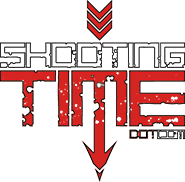Hunter safety or hunting safety is the most important education a hunter can receive. Most hunters will spend countless hours and even days studying animal behavior for a successful hunt, but few will spend more than a couple of minutes brushing up on hunter safety. The most important thing in hunting is making it home safely to your loved ones. Unfortunately, far too many hunters do not make it home safely. Accidental fatal shootings, deadly falls, drownings, and many other unfortunate occurrences could have been avoided with the proper hunting safety training.
This page will break down hunting safety or hunter safety into the sections. Click on a section to immediately go to it on this page.
General Hunter Safety Training
The Basics of Hunter Safety
In our opinion, here are the staples of hunter safety. If these safety suggestions are followed, almost all hunting accidents can be prevented. You will notice that after this expandible list of hunter safety suggestions is our “Tree Stand Safety” section. This is because tree stand injuries/falling injuries account for over 50% of all hunting safety incidents.
Click on each one for more information
[accordions]
[accordion title=”Understand how your firearm works.” load=”hide”]You should know how your firearm works before attempting to use it in the field. This means knowing how to properly load and unload your gun, how to use the safety, and how to disassemble and reassemble it in case it jams.[/accordion]
[accordion title=”Keep your firearm pointed in a safe direction.” load=”hide”]Never point your firearm at another person even if for only a moment. It’s pretty simple, if a gun is never pointed towards something, it will never be able to shoot it.
When walking with a firearm, either cradle carry your firearm so that it points down at the ground or rest it on your shoulder so that it points upwards towards the sky.
If you are in a blind or in other cover, securely position your gun so that it is not pointing at someone nor can it be bumped or fall towards someone.[/accordion]
[accordion title=”Keep your gun’s safety on when not shooting.” load=”hide”]A gun’s safety is a mechanical device that can fail, but when it is in good working order, it helps to prevent accidental firing of your firearm. Be mindful to keep your safety on in all circumstances prior to firing at your intended target.
It does not save any time to have your safety already “OFF” before shooting at a target. In the motion it takes to raise the gun to the firing position, one can easily push the safety to the “OFF” position.[/accordion]
[accordion title=”Unload your gun when crossing obstacles or hoisting it to treestands.” load=”hide”]Simply put, when you cannot have two hands on your gun and control the direction it is aiming at, unload your gun. This goes for crossing fences, climbing steep hills, handing your gun to someone at a different elevation, and hoisting or lowering your gun with a rope.
If you can fall, if the gun can be dropped, or if anything else can accidentally set off the trigger, you will not want your gun loaded.[/accordion]
[accordion title=”Never swing your gun outside the safe zone of fire.” load=”hide”]There is a safe zone of fire should always be respected while shooting game in the field. The zone of fire is a 45° to 50° angled area in which hunters can safely discharge their firearm. If you swing outside this safe zone of fire, you are endangering the safety of others in your hunting party.
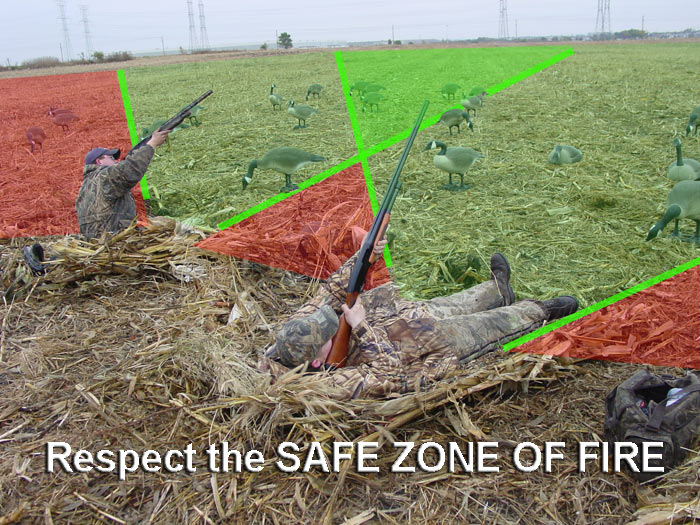
This rule is simple, makes sense, and is easy to follow until we get caught up into the action of the hunt. When a pheasant, duck, goose, rabbit, other other game crosses this invisible line while we are already tracking it with our gun, we have to make the conscious decision to stop and not cross the shooter’s line with our gun.
Swinging into other shooters while following game is a very common way people (friends, sons, fathers, etc.) are shot at point blank range. [/accordion]
[accordion title=”Wear fall protection while hunting from an elevated platform.” load=”hide”]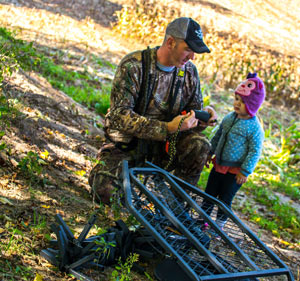 This goes for all treestands whether they are ladder stands, hang-on stands, climbing treestands, or permanent wooden treestands.
This goes for all treestands whether they are ladder stands, hang-on stands, climbing treestands, or permanent wooden treestands.
Falls from treestands account for over 50% of all hunting accidents. Let me repeat, over 50%…. It is not that the hunter hurt wasn’t physically able to climb or maneuver successfully it’s just that sometimes things fail.
Treestand chains, cables, climbing sticks, screw-in steps, ladder stand ladders, platforms, and many other components of elevated hunting systems can fail due to many different factors. These factors include but are not limited to: internal/external rust, years of use, improper installations, modifications, and manufacturing flaws.
Don’t leave it up to chance, invest in a safety harness system for when hunting from elevated platforms.[/accordion]
[accordion title=”Be sure of your target before shooting your firearm.” load=”hide”]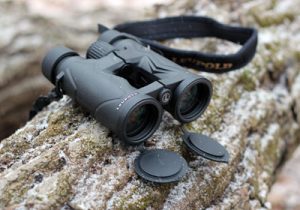 Make sure you visually identify your target before shooting at it. Every year, many people are killed by being mistaken for an animal. If you cannot tell what it is you are going to shoot at, don’t. If something is brown or another earth tone and moves, it doesn’t mean it’s an animal.
Make sure you visually identify your target before shooting at it. Every year, many people are killed by being mistaken for an animal. If you cannot tell what it is you are going to shoot at, don’t. If something is brown or another earth tone and moves, it doesn’t mean it’s an animal.
Use a good quality pair of optics to aid you in identifying the animal you intend on shooting. Also be sure of the location of other people in your hunting party.[/accordion]
[accordion title=”Be sure of what is behind your target” load=”hide”]This goes for both rifle and shotgun hunting; make sure you know what is beyond your target. Modern firearms can send deadly lead a long ways so make sure you are not jeopardizing anyone’s safety while shooting your gun.
If you’re view of what is beyond your hunting area is obstructed, physically go and check it out. If you are hunting with a rifle or similar firearm, never shoot a “skylined” animal. Bullets can travel a great distance and fall with enough speed to kill a person.[/accordion]
[accordion title=”Respect the water.” load=”hide”]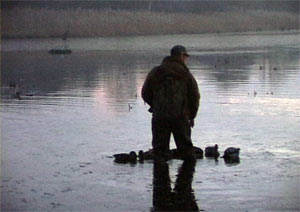 Hunters drown every single year due to taking unnecessary risks.
Hunters drown every single year due to taking unnecessary risks.
Trust me, a limit of mallards or a couple geese are not worth your life. Follow these steps to help yourself stay safe in the water:
- While in a boat, make sure you have the necessary/required safety equipment. This refers to life jackets, throw cushions, a functioning kill switch, a whistle, etc.
- Always wear your life jacket while in a boat.
- Do not overload a boat. Mind the capacity/load limit of your watercraft.
- Do not risk boating in dangerous conditions. Capsizing a boat will lead to drowning/death in many cases especially if you have waders on.
- When wading in lakes, ponds or rivers, be careful not to go over your waders. Many of us have pushed the limits with this one, but if you are almost in too deep of water and hit a steep drop off, you may find yourself fighting for your life with completely submerged waders and multiple layers of hunting clothes. Know your limits.
[/accordion]
[accordion title=”Be prepared for the weather you may encounter.” load=”hide”]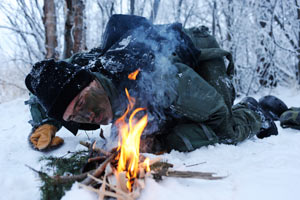 This refers to extreme heat and extreme cold. Don’t let hypothermia or heat stroke put your health in jeopardy. Know what weather you are in for and dress for it.
This refers to extreme heat and extreme cold. Don’t let hypothermia or heat stroke put your health in jeopardy. Know what weather you are in for and dress for it.
If you are going to be exposed to extreme heat and rigorous physical activities, make sure you have plenty of water.
If you are going out in cold temperatures, make sure you have plenty of clothes. Windchills and wet conditions induce hypothermia to many unsuspecting hunters. If you are going to be a great distance from your vehicle or civilization make sure you have an emergency kit in your pack to help yourself stay warm until help arrives. Be prepared.[/accordion]
[accordion title=”Don’t get lost.” load=”hide”]Use a GPS device, maps, and hunt with someone who is familiar with your hunting area to keep from getting lost. Life gets busy and sometimes we don’t have time to plan properly, but cutting this corner can leave you for dead.
When you are hunting an unfamiliar land or a familiar land, you can get turned around, disoriented and start to panic. When you are lost and you panic, you can make bad decisions.
Have the proper tools to keep from getting lost. Have a backup plan incase these tools fail. Carry , emergency food rations, water or emergency water filtration device, an emergency whistle, flare, or other signalling device in case of emergency.
Remember, it is better to be over-prepared than underprepared. [/accordion]
[/accordions]
Treestand Safety
Hunting from a treestand gives you the advantage over big game animals like deer because you’re out of their main line of sight and your scent dissipates easier from an elevated platform. The downside to treestand hunting is the potential for injury or death due to falling. It doesn’t matter what state you are in, falls from treestands almost always account for over 50% of all hunting accidents every year.
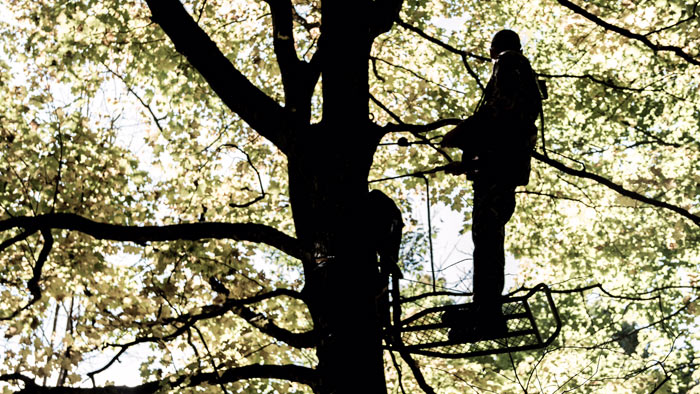
We are going to look at some treestand injury statistics and methods/devices we can use to ensure we stay safe while hunting from an elevated platform.
Statistics of Treestand Injuries
- 82% of hunters injured from treestand falls were not wearing a safety harness.
- 50% of treestand injuries were due to a fall from the elevated platform/treestand.
- 20% of the falls happened while the hunter was descending.
- 30% of the falls happened while the hunter was ascending.
- Hunters can reach a speed of 30 mph during a fall.
- It is estimated that 1 out of every 10 hunters who use treestands will become injured each year. (1)
- Up to 10% of all falls from treestands result in permanent injury or death.(2)
How to Safely Access and Hunt from a Treestand
To safely access and hunt from a treestand, follow the steps below:
- Purchase and wear a hunting safety harness. Make sure you have a proper fit. The harness should be snug; not too tight or loose.
- Purchase and install a lifeline on every treestand/tree that you plan on hunting. For ladder, hang on, and permanent treestands, you should tie the lifeline to the tree above your stand and at the base of the tree or ladder. For the lifeline to be effective, it has to be accessible while climbing and be taut enough for working the prusik knot up and down the lifeline.

Fasten lifeline to the tree above your treestand. 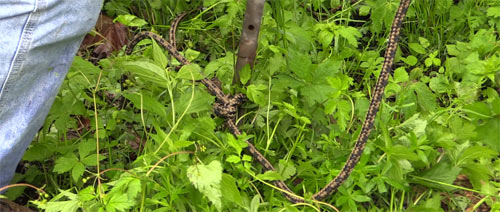
Attach the lifeline to the base of the tree or treestand. - With your hunting safety harness on, tie off your carabiner to the prusik knot and start your climb.
- While climbing, maintain 3 points of contact while move the prusik knot up the lifeline as you climb.
- When you reach your platform, stay tied off to the lifeline.
- To descend safely, simply reverse the process.
When your season is over, carefully remove your lifeline and store it until next season. Leaving the lifeline installed year round will expose it to unnecessary damage from weather and other factors.
How to safely hunt from a climbing treestand
To safely hunt from a climbing treestand, follow these steps:
- Purchase and wear a hunting safety harness. Make sure you have a proper fit. The harness should be snug; not too tight or loose.
- Install your climbing treestand to the tree you’re going to hunt.
- Fasten your safety strap or rope around the tree above the seat section of your climbing treestand.
- Tie off to the safety strap or rope.
- Move and snug your safety strap or rope to the tree as you climb.
- Stay tied off while hunting and to descend, just reverse the process.
What could happen if you don’t tie off? Watch this video.
Using a rope to hoist your firearm, crossbow, or bow to your treestand
You should always use a rope to hoist your firearm, crossbow or bow to your treestand while hunting. Carrying hunting equipment while you climb compromises safety. To safely hoist your hunting equipment to your treestand, follow these steps:
- Unloaded your firearm, crossbow, or if you are using a bow, remove any nocked arrows.
- Securely tie or clip your firearm, crossbow or bow to your hoist rope and test to see that it is secure.
- Tie off and safely climb your tree.
- Hoist your equipment.
- To lower hunting equipment, unload, tie or clip securely, and lower to the ground.
Many fatalities have occurred as a result of hunters hoisting up loaded weapons. Firearms can be fired unexpectedly and injure or kill a hunter when triggers snag on branches, the hoist rope activates the trigger or the firearm falls due to rope breaks or bad knots/clips. Unload your firearm before hoisting it up to a treestand.
Learn from the past to hunt safely in the future
Here is a collection of hunting safety incidents from a variety of different states. We hand-selected the incidents that seem to repeat or are common throughout multiple states. Read over these good. These happened to real people who had enjoyed hunting for many years until one unfortunate turn of events. Could these accidents have been prevented? What can you do to ensure this doesn’t happen to you?
Hunter Safety Incidents
| Hunter Safety Incidents to Learn From | |||
|---|---|---|---|
| Animal Hunted | Casualty Type | Age | Accident Description |
| Deer | Fatal | 10 | Youth hunter was in an elevated treestand pulling up a loaded firearm by a haul line that was attached to the trigger guard. The victim was climbing the ladder up to the stand when the firearm discharged striking him in the abdominal area. Victim passed away 3 days later as a result of the injury.(3)
*Unload your gun when crossing obstacles or hoisting it to treestands |
| Deer | Fatal | 66 | Hunter was attempting to climb out of his homemade ladder stand when the camouflage netting blew over his head causing him to lose his balance and fell 8-10 feet . He suffered severe injuries; a ruptured spleen, fractured hip, fractured spine and broken tibular. He succumbed to the injuries four days after the fall. Was carrying his equipment and No Fall Arrest System was used.(3)
*Wear fall protection while hunting from an elevated platform |
| Deer | Fatal | 53 | Shooter shot before legal time, before shooting light at what appeared to be a deer. The 53 year old shooter killed a father and injured a son.
*Be sure of your target before firing your firearm |
| Quail | Major | 65 | The former Vice President of the United States was quail hunting and accidentally shot his friend. A quail was scared up, Cheney tracked it with his gun, swung outside the “safe zone of fire” and shot. His friend suffered a collapsed lung and had to undergo exploratory surgery. B-Bs from Cheney’s shot missed his friend’s carotid artery by millimeters.
*Never swing your gun beyond the “safe zone of fire” |
| Duck | Fatal | 22 | Hunter’s dog went out onto thin ice while trying to retrieve a downed duck and broke through the ice. The hunter went out to rescue his dog and fell victim to the icy water. Both the hunter and the dog drowned.
*Respect the water |
| Deer | Fatal | 50 | Hunter drew his rifle on a deer and shot. His bullet missed the deer and struck a 67 year old man, killing him instantly. The victim was not in sight of the shooter.
*Be sure of what is behind your target |
| Squirrel | Major | 40 | Hunter grabbed his gun and was pulling it towards himself when the trigger caught on a piece of wire and discharged, resulting in a self inflicted gunshot wound.
*Keep your firearm pointed in a safe direction |
| Elk | Fatal | 38 | Hunter went missing on an elk hunting trip and was found two years later by a rancher. He died of hypothermia and exposure.
*Don’t get lost (use a GPS, maps, and have emergency provisions on hand) |
Final Thoughts on Hunter Safety
Hunters, and people in general, inherently take the path of least resistance. We will opt for the easy way to do things to conserve energy and spend it on what we believe to be more important. We will spend hours on end researching how to successfully harvest an animal we want but one important thing we often ignore is how to harvest that animal safely.
Thousands of people get injured or killed every year by not using safe hunting practices. Many hunters think they are at the top of the food chain and are indestructible but all it takes is a simple lapse in judgement or an equipment failure to change their life forever. With the help of this page, we hope we opened your eyes to a safer way to hunt. Like many things in life, hunting safely takes effort but isn’t your life worth it?
References
-
- https://www.ncbi.nlm.nih.gov/pmc/articles/PMC4133424/
- https://www.ncbi.nlm.nih.gov/pubmed/20836352
- https://www.dnr.illinois.gov/safety/Documents/HuntingIncidentsSummary2015.pdf
